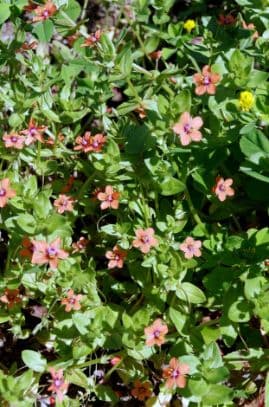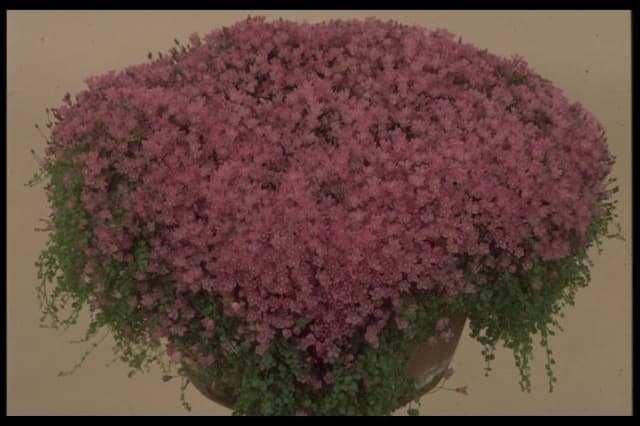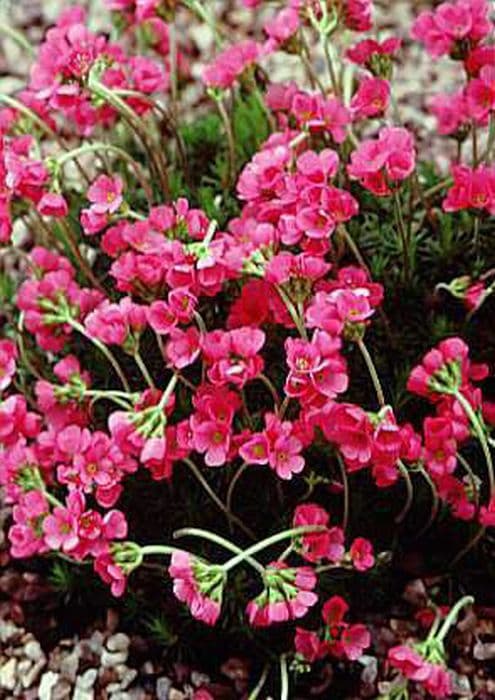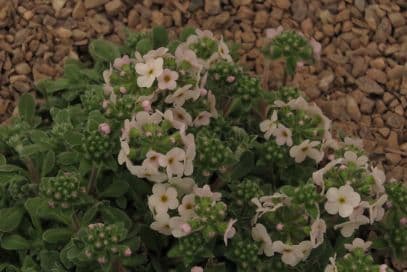Rock Jasmine Androsace sempervivoides

ABOUT
Androsace sempervivoides, commonly known as the Rock Jasmine, is an alpine flowering plant noted for its interesting form and beautiful floral display. It has a low-growing, mat-forming habit, typically creating dense cushions of greenery. The leaves are small, numerous, and may be slightly hairy, often forming rosettes. They possess a succulent appearance, reminiscent of some stonecrop varieties, contributing to the plant's overall lush, textured look. The charm of the Rock Jasmine lies in its blossoms, each consisting of multiple small flowers clumped together at the top of short flower stalks. These blossoms are typically white or pale pink with a central yellow or deeper pink eye which provides a delightful contrast against the green foliage. The petals are delicate and rounded giving the flower clusters a soft, frilly appearance. When in full bloom, the plant is adorned with these cheerful clusters, creating an appealing display that can capture the attention and interest of gardeners and nature enthusiasts.
About this plant
 Names
NamesFamily
Primulaceae
Synonyms
Rock Jasmine, Live-forever Androsace
Common names
Vitaliana sempervivoides, Androsace vitaliana subsp. sempervivoides, Douglasia sempervivoides.
 Toxicity
ToxicityTo humans
Androsace sempervivoides, commonly known as Rock Jasmine, is not widely known for its toxicity to humans. There is little information available on the toxicity of Rock Jasmine to humans, and it is not typically listed as a poisonous plant. However, as with any plant, individual allergies and sensitivities can occur. If symptoms of an allergic reaction or poisoning appear after ingesting any part of the plant, such as gastrointestinal distress, skin rash, or trouble breathing, medical attention should be sought.
To pets
Rock Jasmine is not commonly documented as a toxic plant to pets. There is limited information regarding its toxicity in pets, but it is generally not considered poisonous. Nonetheless, pet owners should always be cautious and prevent pets from ingesting plants, as individual animals may have unique susceptibilities, and some may exhibit mild gastrointestinal upset if they consume parts of the plant. If you suspect your pet has eaten Rock Jasmine and is showing signs of distress, consult your veterinarian.
 Characteristics
CharacteristicsLife cycle
Perennials
Foliage type
Evergreen
Color of leaves
Green
Flower color
Pink
Height
0.1 feet (3 cm)
Spread
0.5 feet (15 cm)
Plant type
Herb
Hardiness zones
5
Native area
Himalayas
Benefits
 General Benefits
General Benefits- Ornamental appeal: Androsace sempervivoides, commonly known as Rock Jasmine, has attractive foliage and flowers that can enhance the aesthetic value of gardens and landscapes.
- Drought resistance: Rock Jasmine is adapted to survive in dry conditions, making it suitable for rock gardens and xeriscaping, where water conservation is a priority.
- Low maintenance: This plant requires minimal care once established, making it a convenient choice for gardeners with limited time.
- Cold hardiness: Rock Jasmine can withstand cold temperatures, which makes it suitable for alpine and mountainous regions.
- Pollinator attraction: The flowers of Rock Jasmine attract bees and butterflies, helping to support local ecosystems and pollination.
- Erosion control: When used in rockeries or slopes, the root system of Rock Jasmine helps to stabilize soil and prevent erosion.
- Compact growth: Its small size and compact growth habit make it ideal for use in containers, small gardens, or as a ground cover.
 Medical Properties
Medical PropertiesThis plant is not used for medical purposes.
 Air-purifying Qualities
Air-purifying QualitiesThis plant is not specifically known for air purifying qualities.
 Other Uses
Other Uses- Rock garden decoration: Androsace sempervivoides, known as the rock jasmine, is well-suited for rock and alpine gardens due to its compact form and ability to grow in rocky crevices.
- Fairy gardens: The miniature size of rock jasmine makes it an ideal choice for fairy gardens where it adds a touch of whimsy and scale-appropriate foliage.
- Ground cover: Rock jasmine can serve as an attractive ground cover in areas with cool summers, creating a dense mat of small rosettes that inhibit weed growth.
- Green roof planting: Its tolerance to drought and shallow root systems makes rock jasmine a suitable plant for green roof installations.
- Photography subjects: The delicate flowers and interesting growth form of rock jasmine make it a popular subject for macro and nature photographers.
- Garden borders: A low-growing plant like rock jasmine is often used to define the edges of garden beds and paths.
- Education: Rock jasmine can be used as a teaching tool in botany and horticulture classes, illustrating alpine plant adaptations or the Saxifragaceae family.
- Container gardening: Due to its small size, rock jasmine can thrive in containers, allowing gardeners with limited space to enjoy its beauty.
- Bonsai: Although not a traditional bonsai plant, the rock jasmine's petite size and resilience make it a candidate for bonsai experiments.
- Erosion control: When planted on slopes, rock jasmine's root system can help stabilize the soil and prevent erosion.
Interesting Facts
 Feng Shui
Feng ShuiThe plant Androsace sempervivoides is not used in Feng Shui practice.
 Zodiac Sign Compitability
Zodiac Sign CompitabilityThe plant Androsace sempervivoides is not used in astrology practice.
 Plant Symbolism
Plant Symbolism- Endurance and Survival: The common name "Rock Jasmine" suggests delicacy, but Androsace sempervivoides often grows in rocky, alpine conditions, symbolizing its ability to endure harsh climates and survive where other plants may not.
- Persistence: The species name 'sempervivoides' implies 'resembling the sempervivums' which are known for their tenacious nature; thus, Rock Jasmine embodies the trait of persistence, thriving amidst adversity.
- Adaptation: Rock Jasmine is capable of adapting to its environment, often found clinging to crevices and ledges, symbolizing the plant’s versatility and ability to adjust to different scenarios.
- Innocence and Delicacy: As with many small flowering alpines, the Rock Jasmine's delicate blossoms suggest a symbolism associated with innocence and the more delicate, softer sides of nature.
- Longevity: Given its evergreen nature, Rock Jasmine may represent longevity and the continuous cycle of life, as it keeps its leaves throughout the year, symbolizing eternal life or immortality.
 Water
WaterRock Jasmine should be watered regularly yet cautiously, as it prefers moist but not waterlogged soil. During the growing season, water the plant when the top inch of soil feels dry to the touch, typically every 5 to 7 days. Use enough water to moisten the soil throughout the pot, but be sure to allow any excess to drain away. Depending on the pot size, this may be approximately 8-16 ounces of water per week. In winter, reduce watering frequency to prevent root rot as the plant enters dormancy.
 Light
LightRock Jasmine thrives in bright, indirect light. It should be placed in a spot where it can receive a few hours of morning sun followed by dappled or partial shade for the rest of the day. Avoid intense, direct afternoon sunlight as it can scorch the leaves.
 Temperature
TemperatureRock Jasmine performs well in cool to moderate temperatures, ideally between 50 and 68 degrees Fahrenheit. However, it can tolerate temperatures as low as 40 degrees Fahrenheit and as high as 75 degrees Fahrenheit. Avoid exposing the plant to temperatures outside this range to prevent stress and damage.
 Pruning
PruningPrune Rock Jasmine to maintain its shape and encourage bushier growth. The best time for pruning is in early spring, just after the plant finishes blooming. Deadheading spent flowers and trimming back overly long or leggy stems can be done as needed throughout the growing season to keep the plant looking tidy.
 Cleaning
CleaningAs needed
 Soil
SoilThe best soil mix for Androsace sempervivoides, also known as Rock Jasmine, should be well-draining with a mix of loam, sand, and gritty material like pumice or fine gravel. The soil pH should be slightly acidic to neutral, ranging between 6.0 and 7.5, to emulate their native alpine habitats.
 Repotting
RepottingRock Jasmine should be repotted every 2 to 3 years to refresh the soil and accommodate root growth. It's best to repot in spring just before the onset of the growing season, being careful not to disturb the roots excessively.
 Humidity & Misting
Humidity & MistingRock Jasmine thrives in moderate to low humidity environments typical of its native alpine regions. It can tolerate dry air but should be protected from overly humid conditions, which can lead to fungal issues.
 Suitable locations
Suitable locationsIndoor
Place Rock Jasmine in bright, indirect light indoors.
Outdoor
Plant Rock Jasmine in full sun to partial shade outdoors.
Hardiness zone
4-8 USDA
 Life cycle
Life cycleAndrosace sempervivoides, commonly known as Rock Jasmine, initiates its life cycle when the seeds germinate in a suitable environment, typically in alpine or subalpine regions. The seedlings emerge and develop into a rosette form, characteristic of many alpine plants. As it grows, Rock Jasmine establishes a deep root system that allows it to absorb water and nutrients from the rocky soils it often inhabits. The plant reaches maturity and produces small, attractive pink or white flowers during spring or early summer, which are pollinated by insects. Following pollination, the flowers develop into fruit that contain seeds, completing the reproductive stage. The plant endures winter dormancy and resumes its growth cycle in the spring, often living for several years given its perennial nature.
 Propogation
PropogationPropogation time
Spring-summer
Propogation: Androsace sempervivoides, commonly knownas Rock Jasmine, is commonly propagated by seed. The best time for sowing the seeds is late winter or early spring, in well-drained soil mix, covering the seeds lightly with fine grit or compost. It's essential to keep the soil moist but not waterlogged. After sowing, the seed tray should be placed in a cold frame or cool greenhouse, as germination may be slow and could take several weeks to occur. Once seedlings are large enough to handle, they should be pricked out into individual pots and grown on in cooler conditions until large enough to plant out in their final positions. This method is attractive for its simplicity and effectiveness in producing new plants that are true to the parent species.









